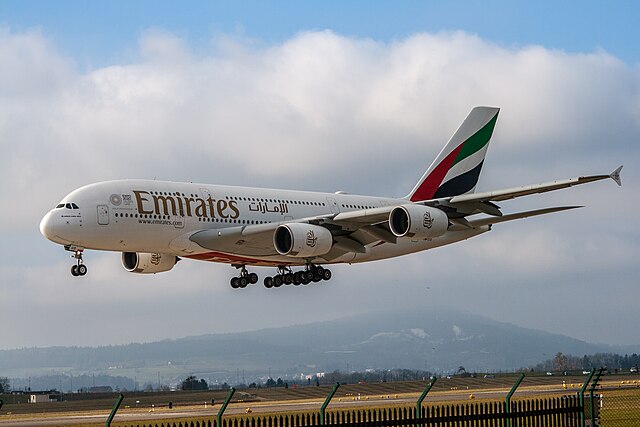
Largest Planes in the World: The 5 Biggest Aircraft Ever Built
5 min read

5 min read
By: The Aviation Co
When it comes to pushing the limits of flight, nothing captures the imagination quite like the world’s largest planes. These massive aircraft (some built to haul cargo the size of a house, others designed to move hundreds of passengers across continents) are physical proof of how far aerospace engineering can go when imagination meets innovation.
Below are the five largest aircraft ever built, each one representing a different era in aviation history, and a unique vision of what it means to fly big.
No aircraft has ever matched the Antonov An-225 Mriya, a Ukrainian-built colossus that once held the title of the largest airplane in the world. Developed in the 1980s by the Soviet Union, the Mriya (meaning “dream” in Ukrainian) was created to transport the Buran space shuttle on its back.
This six-engine cargo plane could haul an astonishing payload of 250 tonnes with a wingspan of 88.4 meters (longer than a football field). Its maximum takeoff weight of 640 tonnes made it the heaviest aircraft ever built. The An-225’s massive fuselage and aerodynamic design allowed it to carry oversized cargo that no other aircraft could handle, from locomotives to wind turbine blades.
Though the Mriya was destroyed in Ukraine in 2022, plans to rebuild it continue, which is a fitting tribute to an aircraft that redefined what was possible.
If the Mriya ruled the cargo world, the Airbus A380-800 reigns in the skies of commercial flight. Introduced in 2007, the Airbus A380 is the world’s largest passenger aircraft: a double-decker, wide-body aircraft capable of seating more than 850 people in an all-economy configuration.
With a wingspan of nearly 80 meters, four-engine turbofan engines, and a smooth cruising speed of Mach 0.85, the A380 was designed for ultra-long-haul routes. Emirates became its biggest operator, turning the aircraft into a flying symbol of comfort with onboard bars, showers, and private suites.
While Airbus ended production in 2021, the A380 remains an icon, and its aerodynamic efficiency and massive payload capacity proves that even in an era dominated by smaller jets, large aircraft still have a place in aviation.
For over five decades, the Boeing 747 has been synonymous with global travel. The latest variant, the Boeing 747-8, stands as both a farewell and a masterpiece, standing as the longest commercial aircraft ever built, measuring 76.3 meters from nose to tail.
With its iconic humpback fuselage, four Rolls-Royce-powered turbofan engines, and spacious cargo hold, the 747-8 was engineered for efficiency and endurance. It could carry up to 467 passengers or 140 tonnes of freight, making it one of the most versatile transport aircraft in history.
Its first flight in 2010 marked the final evolution of an aviation legend. Though Boeing officially ended 747 production in 2023, the aircraft remains beloved among pilots and passengers alike — a testament to the enduring legacy of the “Queen of the Skies”.
Among military transport aircraft, the Lockheed C-5 Galaxy remains unmatched in size and strength. First flown in 1968, this American heavy-lift giant was designed to move the world’s heaviest and most oversized cargo, from tanks to helicopters, across continents.
Its cavernous cargo hold stretches more than 36 meters long, capable of handling a payload of up to 127 tonnes. The C-5’s four-engine design and intercontinental range make it essential for missions that demand reach and reliability.
The modernized C-5M Super Galaxy continues to serve with upgraded avionics and fuel-efficient engines, ensuring this largest cargo aircraft remains one of the U.S. Air Force’s most vital assets in global operations.
Few aircraft are as famous (or as improbable) as the Hughes H-4 Hercules, better known as the Spruce Goose. Built in the 1940s by Howard Hughes, this all-wood flying boat was the answer to wartime restrictions on metal use.
Its wingspan of 97.5 meters remains the largest of any aircraft ever built, even surpassing modern airships and the Stratolaunch spaceplane. The Hercules was intended to serve as a transatlantic transport aircraft for troops and cargo, but it completed only one maiden flight in 1947, cementing its legendary status.
Despite its limited service, the Spruce Goose proved what bold engineering and creative design could achieve. Today, it stands as a monument to ambition and a reminder that even the most improbable dreams can fly, if only once.
Two other massive machines deserve recognition. The Antonov An-124 Ruslan, another Russian-built cargo aircraft, is a smaller sibling of the An-225 but still one of the largest aircraft in the world, capable of lifting up to 150 tonnes. It remains active in heavy transport missions worldwide.
Meanwhile, the Airbus Beluga XL continues Europe’s proud tradition of aerospace innovation, moving aircraft parts between Airbus facilities. With its distinctive whale-like fuselage, it’s one of the most recognizable cargo planes flying today.
From Ukrainian engineering brilliance to American military power and European innovation, these massive aircraft embody humanity’s drive to think (and build) big. Whether carrying passenger capacity records or redefining how we move freight, each represents a different chapter in the story of aviation progress.
Even as the aviation industry shifts toward lighter, more fuel-efficient designs, the legacy of these largest planes in the world remains. They remind us that progress isn’t only about speed or sustainability, but it’s also about daring to imagine the impossible, and finding a way to lift it into the sky.
Which of these giant aircraft do you think had the biggest impact on aviation, and could any modern plane ever match their scale? Dive into discussions like this on The Aviation Co., a space for aviation lovers, frequent flyers, and pros to connect.